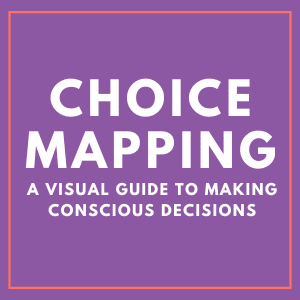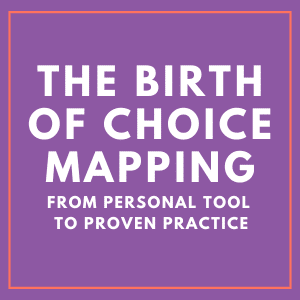One of my earliest clients sat looking at her blank paper, pen hovering uncertainly above it. “I’m afraid I’ll do it wrong,” she said. I smiled, remembering my own first maps with their messy branches and crossed-out words. “The only way to do this wrong,” I told her, “is to try to make it perfect.” An hour later, she held her first map—not perfect, but perfectly hers. “I thought I needed to make it look right,” she said. “But what mattered wasn’t how it looked—it was what I discovered about my choice.”
Your First Map
Let’s start exactly where you are. Choose one decision that’s asking for your attention right now. It might be something significant like a career change, or something that feels smaller but keeps tugging at you. This choice becomes the center point of your map, the hub from which all your exploration will grow.
Don’t worry about crafting the perfect words. I remember a client who spent fifteen minutes trying to phrase her choice “correctly.” When she finally wrote “I choose to explore moving to California,” she laughed. “That wasn’t so hard after all.” What matters isn’t elegant phrasing—it’s capturing what’s true for you right now.
Mapping in Professional Settings
While mapping works beautifully for personal choices, it’s equally powerful in professional settings. I’ve watched leaders use mapping to navigate complex business decisions, teams use it to align on projects, and professionals use it to chart career paths.
Teresa, a marketing director, brought mapping into her weekly planning. Instead of just listing tasks, she began mapping her choices about project priorities. “It changed my whole approach,” she told me. “Instead of feeling overwhelmed by everything I ‘had to’ do, I started seeing each task as a choice about where to invest my energy.”
Another client, James, used mapping to navigate a challenging workplace dynamic. Rather than reacting to difficult situations, he would take five minutes to map his choice about how to respond. This small practice transformed his professional relationships and led to more thoughtful leadership decisions.
The Core Questions
From your central choice, five key questions guide your exploration. These questions emerged through hundreds of mapping sessions, consistently helping people access deeper understanding about their choices:
- Why does this choice matter to you?
- What fears might get in your way?
- How do you want to show up as you make this choice?
- What becomes possible because of this choice?
- What actions will you take to bring your choice to life?
Let each question lead you naturally to the next. As you capture your answers, keep them concise—aim for clear statements that resonate as your truth rather than lengthy explanations.
Following the Thread
Think of mapping as a conversation with yourself —one where you’re both the person asking insightful questions and the one discovering answers. You don’t need to follow these questions in any particular order. Let each answer lead naturally to your next question.
I love watching this unfold in mapping sessions. Recently, Maria began mapping her choice about starting a business. She started with “Why does this matter?” writing simply “freedom to create.” That led her to explore what fears might block her, which unexpectedly opened up a whole branch about what becoming a creator meant to her. “I had no idea that was even there,” she said, “but following one thought to the next helped me see what was really driving my choice.”
Recognizing Daily Choice Points
One of the most valuable skills mapping develops is the ability to recognize choice points in your daily life. Even in situations that feel fixed or predetermined, there are usually more options than we initially see.
Consider Michael’s story. As a physician, many of his daily routines seemed predetermined by hospital protocols. But when he began mapping his workday choices, he discovered numerous moments where he could choose his approach—how to begin patient conversations, when to take brief renewal breaks, how to structure his notes. These small choices, once recognized and consciously made, dramatically improved both his work experience and patient care.
The key is starting to notice these choice points. They might be as simple as:
- How you begin your workday
- When and how you communicate with colleagues
- How you frame challenges that arise
- Where you direct your focus and energy
Each conscious choice, no matter how small, builds your capacity for clearer decision-making in all areas of life.
A Living Document
Your map isn’t meant to be static. It grows and evolves as your understanding deepens. Some people return to their maps days or weeks later, adding new branches as their perspective shifts. Others create several maps for the same choice, each one revealing new layers of understanding.
David, a client mapping his choice about pursuing a graduate degree, created his first map focused entirely on practical considerations—timing, finances, career impact. A week later, he created another map exploring what the choice meant for his personal growth. “Each map showed me something different,” he told me. “Together, they gave me the full picture.”
Making It Your Own
While I’m sharing these guidelines, remember that Choice Mapping is ultimately about finding your way to clarity. Over the years, I’ve watched people develop their own beautiful variations:
- Sarah uses different colored pens to track various aspects of her choices
- Michael creates digital maps he can easily update and expand
- Elena prefers sticky notes she can move around as her thoughts evolve
- James keeps his maps minimal, focusing on just a few key insights
What matters isn’t the method—it’s the meaning you discover.
Starting Where You Are
The most important thing to remember as you create your first map is this: you already know how to think about your choices. Mapping simply gives you a way to see your thinking more clearly. It’s like turning on a light in a room you’ve been navigating in the dark—everything was already there, but now you can see it.
Begin with that one choice that’s asking for your attention. Trust that the insights you need will emerge as you engage in this visual dialogue with yourself. Don’t worry about getting it “right”—focus on getting it real.
The practice is yours to explore. Let your natural curiosity guide you. Trust that the insights you need will emerge as you engage in this visual dialogue with yourself.
In the articles that follow, I share more specific techniques for working with different types of choices. For now, begin with one choice that matters to you. Create your map not with the goal of perfection, but with the intention of discovering what’s true for you in this moment. As your practice develops, discover how Choice Mapping reveals unexpected possibilities.
Take Your Next Step with Mapping
Get your copy of The Book of Choice or practice mapping live in my free interactive workshop: The Creative Art of Choice Mapping.








